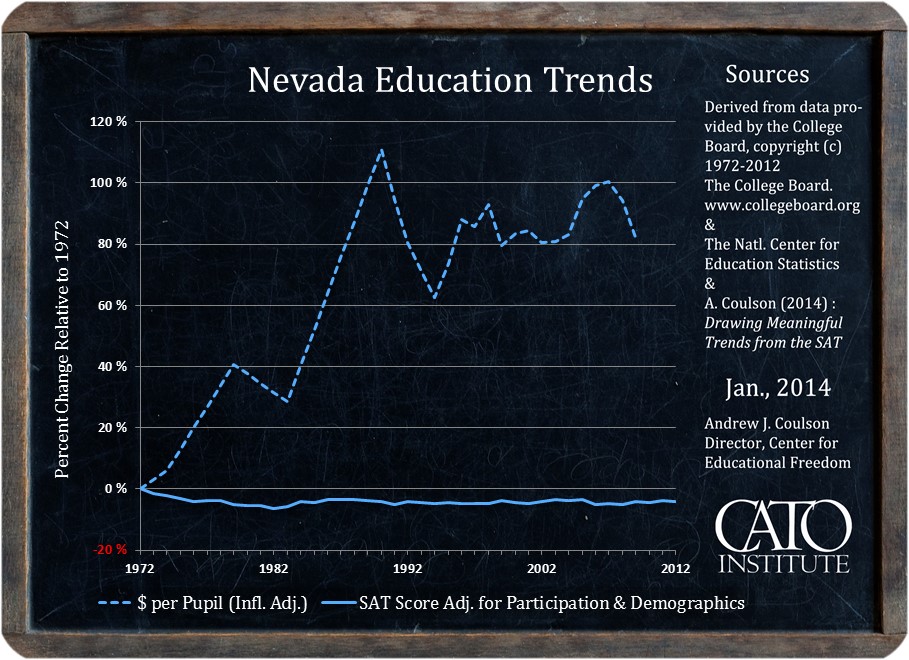Nevada K-12 Education Policy and Spending: Ground Hog Day

The liberal Washington Post recently reported that: “Scores on the SAT have sunk to the lowest level since the college admission test was overhauled in 2005, adding to worries about student performance in the nation’s high schools.”
Long-term K-12 student achievement results — especially in light of substantial real increases in per-student funding and large cuts in pupil-to-teacher ratios — are worse nationally and in Nevada than even that assessment.
The Post noted that the steady declines in SAT scores are matched by stagnant results from high schools on federal tests and other measures. It added that, “gains in reading and math in elementary grades haven’t led to broad improvement in high schools, experts say.”
Last year, the Cato Institute produced a major analysis of K-12 spending and SAT scores since 1970. It found that, despite huge increases in real spending per student, average performance, adjusted for student demographics and test participation levels, is essentially unchanged since data collection began in 1970.
The adjustments compensate for the facts that scores are usually lower for minority and low-income students, whose percentages among test takers have increased. Also, that scores decline as the fraction of the graduating class taking the test increases, because the better students were already taking the tests before and the ones added subsequently are generally lower performers.
From the low statistical correlations between state-level real per-student spending and scores, the analysis concluded there “is essentially no link between state education spending (which has exploded) and the performance of students (which has generally stagnated or declined).”
The study noted that SAT score declines reflect the “stagnating achievement” seen in the National Assessment of Educational Progress (NAEP). “That disappointing record comes despite a more-than-doubling in inflation-adjusted per pupil public-school spending.” The average real, per-student state-level spending increase was 120 percent.
It found that, “America’s educational productivity appears to have collapsed, at least as measured by the NAEP and the SAT.”
“That is remarkably unusual. In virtually every other field, productivity has risen over this period thanks to the adoption of countless technological advances — advances that, in many cases, would seem ideally suited to facilitating learning. And yet, surrounded by this torrent of progress, education has remained anchored to the river-bed, watching the rest of the world rush past it.”
It added that the few multi-year spending cuts totaling 20 percent or more experienced in some states during parts of the 40-year period also had almost no effect on scores — both during the cuts and the few years thereafter. “Indeed, their score trends seem entirely disconnected from their rising and falling levels of spending.”
The analysis concluded: “Two generations seems a long time for a field to stand outside of history, particularly when those generations have witnessed so many reforms aimed at improving education. Perhaps it’s time to ask if there are inherent features in our approach to schooling that prevent it from enjoying the progress typical in other fields.”
For Nevada, the analysis showed that adjusted scores have been essentially constant over the last 40 years, even as total Nevada state and local K-12 real per-student spending rapidly increased in the 1970s and 1980s and then leveled off through about 2008 (the last year of combined spending data).
So, what did our Governor and Legislature do this year? They repeated the same K-12 mistakes the state has made various times in recent decades. They vastly increased spending on new and existing programs — some as yet unproven and some already known failures.
They again wantonly threw your tax dollars at selfish special-interest groups that will be as predatory upon the voters, taxpayers and public interest as the Legislature and Governor allow them to be: teacher unions (which will repay them with campaign contributions) and feckless or worse large county school districts. Once again, it was all applauded by the crony big business interests that pay political protection money to the K-12 and union establishment and the statist political and media classes.
So, it’s unsurprising that, as one large county school district bragged about its recently increased graduation rates, a major newspaper headline in that county said: “As grad rates rise, college readiness lags.” With “rise” and “lags” in large type.